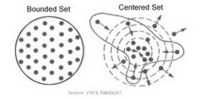Adam Hamilton’s Seeing Gray in a World of Black and White: Thoughts on Religion, Morality, and Politics is a perfect blog book. I would love to see a host of evangelical churches using this book for group studies and discussions. It will surely bring out how it is that many think about various topics; it will also reveal what folks think.
What Hamilton makes clear to me is that the Third Way is not the way of compromise; instead, it is the way working out a Christian view of things regardless of which “party” prefers that option. It is a refusal to be an ideologue, a refusal to say “liberal is always right” or “conservative is always right.”
Do you think the middle is expanding? Do you see a trend for those on the right to move to the middle? Is a radical center attractive to you? Both politically and theologically? Overall, what do you think of this book?
It is common to hear that one has to be clear and consistent and courageous and choose-one-side-or-the-other and stay there to have popular appeal. In other words, either be Left or Right. That claim also says the middle is the way of compromise and few find that way. The last election and the rising tide of Christians who are tired of the either-or approach bodes well for the rise of a Third Way approach. Hamilton calls this the “radical center.” He doesn’t think the word “moderate” is good enough (and I confess to having used this term for myself in numerous settings but I’ll be hesitant after his suggestion that “moderate” means tepid too often). So what does he suggest?
First, he suggests that there is, in his view, an irreversible shift from the conservative to the center and from the left to the center. He’s seeing it in both conservatives shifting to the middle (politics, emerging church, and an assortment of anecdotal experiences with shifting) and in liberals shifting toward the middle (rise of church planting, evangelism, etc).
Second, he thinks conservative Christians now are right where the mainlines were in the 1960s. “But I believe these churches are likely to see their growth stalled, and then to watch a period of decline, unless they recognize the changes happening in society that will leave them increasingly disconnected from emerging generations” (228).
Third, he does not seem to see the future in the mainline or liberal tradition; it is in a Third Way — in the gray — in seeking and living out the best of both traditions. He sees Third Way in Zondervan’s TNIV (inclusive version), in the increase in women in leadership among conservative churches, of speaking against global warming, of Christianity Today’s articles on AIDS and war and poverty, in Bill Hybels and Rick Warren … there is a shift toward the middle.
Fourth, he sees the heart of Third Way in a gospel that is both personal and social, that grace and love need holiness, that progress requires fidelity to historic truths, that Scripture is both God’s Word and man’s words … and Third Way folks will avoid demonizing either side and will exercise charity toward both the left and right.
Thanks Adam.
